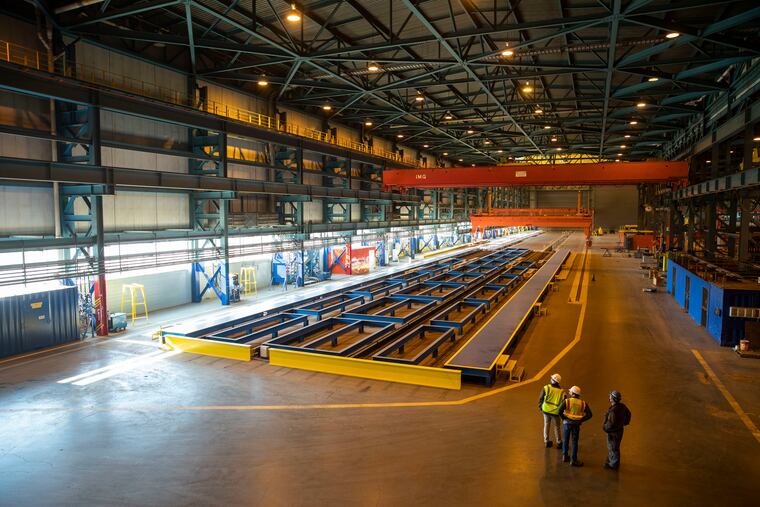Philadelphia’s shipyards once boomed. Why do they struggle for funding now? | Opinion
The proposed infrastructure spending bill is massive, yet there’s nothing specifically for shipyards.

I’ve always loved the movie Field of Dreams. In one scene, Kevin Costner’s character, after taking significant risks and doing everything he was asked to do, poses a question: “What’s in it for me?”
Given the situation, that’s not a selfish question. That’s a legitimate attempt to obtain clarity. Today, the people in the Philadelphia area — including Pennsylvania’s 5th Congressional District in Delaware County, where I am running for Congress — should be asking the same thing when it comes to the federal infrastructure bill.
» READ MORE: House approves $715 billion transportation, water bill
Several months ago, President Joe Biden proposed a massive $2 trillion dollar package that aimed to improve our nation’s aging infrastructure, including highways, bridges, and ports. A tentative $1.2 trillion deal has been reached between a group of Senate Republicans and Democrats, but the final cost and contours of the legislation are far from certain. Significant differences remain surrounding a host of projects in the president’s plan — like electric vehicle charging stations — that would arguably have little infrastructural and economic impact in the lives of most Americans for years to come.
Both political parties acknowledge an urgent need to revitalize our infrastructure and its associated economic opportunities. As a result of this push and the significant spending it will take to enact it, our elected leaders must avoid the partisanship and pet projects that typically plague massive bills like this.
If Congress is to pass a bill of $1 trillion or more, we must ensure every dollar helps to immediately revitalize our infrastructure while creating jobs and benefiting the local economy. We need to invest in sure things — not ideological wish lists or nascent sectors that are unlikely to generate employment in the near future. Nor can we expand the definition of infrastructure so widely that any expenditure can be justified.
“Shipbuilding is in our DNA. Philadelphia is the birthplace of the U.S. Navy.”
Working families, many of whom are still reeling from COVID-induced disruption, need more than the promise of a filled-in pothole, bike path, or a hypothetical job in a still immature industry. They need a vision of and a clear path to lasting prosperity. For residents of our region, that should start with a renewed sense of urgency and funding to restore our shipyards.
Shipbuilding is in our DNA. Philadelphia is the birthplace of the U.S. Navy and we live beside a major river. The Navy is a big part of my life: I’m a graduate of the U.S. Naval Academy, and spent more than seven years on active duty as a Navy Explosive Ordnance Disposal officer. Our region needs funding for another shipyard and dry dock, as well as resources to expand and modernize our existing facilities. These steps will create thousands of persistent, wage-enhancing jobs and kick-start a manufacturing renaissance in our local economy.
In our not-so-distant past, our shipyards were booming, and firms like Sun Shipbuilding & Dry Dock and the Philly Shipyard were leaders of a dynamic industrial ecosystem. Our region and nation flourished as our yards facilitated economic activity, buoyed families, and supported our nation’s defense.
» READ MORE: ‘The sun is shining’ at Philly Shipyard as hundreds of jobs return this year, CEO says
Now, for many reasons — such as massive investments in shipbuilding by other countries — our shipyards have atrophied. Sun is defunct. The Philly Shipyard employs only a few hundred people, down from almost 40,000 in World War II (though some jobs are coming back). Not only have workers and families suffered as a result, but so has our national security. The U.S. has less than 160 active shipyards; China has an estimated 1,200. Our Navy plans to commission seven warships in 2021; China commissioned three in April alone. Totals for oceangoing merchant vessels reflect a similar disparity.
The U.S. Navy has set a goal of creating a fleet of 355 ships, but said in a 2019 report that it needs additional investments and resourcing to get there. Simply put, the Navy lacks the shipyard and dry dock capacity it requires to both produce ships fast enough, but also the facilities and workforce to refurbish and repair a growing fleet.
We cannot afford to delay any longer. We must act now.
Out of Biden’s $2 trillion plan, $17 billion is earmarked for inland waterways, coastal ports, land ports of entry, and ferries. But nothing specifically for shipbuilding. So, I ask, what is in it for us?
Infrastructure funding for shipyards, coupled with our proximity to military facilities like Norfolk Naval Base, will make our region an attractive recipient for follow-on projects and investment. We can invest in expanding our skilled manufacturing workforce and create incentives that encourage work in industries that contribute to the national defense, which will help revitalize our region for a generation.
Americans cannot afford this level of spending without seeing transformative, impactful, and immediate results. As this debate continues and an agreement is reached, nobody in Delaware County or the Philadelphia area should be left asking, “What’s in it for me?”
Dave Galluch is a candidate for U.S. Congress in Pennsylvania’s 5th District. He resides in Newtown Square with his wife, Caroline, and works for the Comcast Corporation.